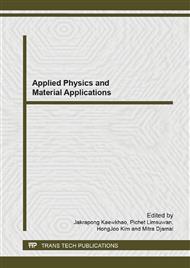[1]
J. Daughton, J. Brown, R. Beech, A. Pohm, W. Kude, Magnetic Field Sensors Using GMR Multilayer, IEEE Trans. Magn. 30 (1994) 4608-4610.
DOI: 10.1109/20.334164
Google Scholar
[2]
C. Smith, R. Schneider, T. Dogaru, S. Smith, GMR Magnetic sensor Arrays for NDE Eddy-current Testing, Review of progress in quantitative NDE, AIP Conf. Proc. 657 (2003) 419-426.
DOI: 10.1063/1.1570166
Google Scholar
[3]
C. Reig, M.D.C. Beltran, D.R. Munoz, Magnetic Field Sensors Based on Giant Magnetoresistance (GMR) Technology: Application in Electrical Current Sensing, Sensors. 9 (2009) 7919-7942.
DOI: 10.3390/s91007919
Google Scholar
[4]
R. Wood, Future hard disk drive systems, J Magn Magn Mater. 321 (2009) 555-561.
Google Scholar
[5]
S. Tehrani, E. Chen, M. Durlam, T. Zhu, H. Goronlun, High Density Nonvolatile Magnetoresistive RAM, International Electron Devices Meeting (IEDM'96). (1996) 193-196.
DOI: 10.1109/iedm.1996.553152
Google Scholar
[6]
T. Shinjo, Nanomagnetism and Spintronics, Elsevier, Oxford, 2009.
Google Scholar
[7]
M. Djamal, Ramli, F. Haryanto, Khairurrijal, GMR Biosensors for Clinical Diagnostics, in: P.A. Serra (Ed.), Biosensors for Health, Environment and Biosecurity, InTech, Rijeka, Croatia, 2011, p.149 – 164.
DOI: 10.5772/16365
Google Scholar
[8]
F. J. Himpsel, Electronic states in magnetic nanostructrures, IBM J. Res. Dev. 42 (1998). 33–42.
Google Scholar
[9]
A.S. Penfold, Magnetron Sputtering, in D.A. Glocker, S.I. Shah (Eds.). Handbook of Thin Film Process Technology, (1995), Institute of Physics, College Park, MD, pp.1-26.
Google Scholar
[10]
M.N. Baibich, J. M. Broto, A. Fert, N. van Dau, F. Petro, P. Eitenne, G. Creuzet, A. Friederich, J. Chazelas, Giant Magnetoresistance of (001)Fe/Cr(001) Magnetic Superlattice, Phys. Rev. Lett. 61 (1988) 2472-2475.
DOI: 10.1103/physrevlett.61.2472
Google Scholar
[11]
M. Jergel, S. Luby, A. Anopchenko, E. Majkova, M. Spasova, V. Holy, M. Brunel, A. Luches, M. Martino, An interplay between the structure and giant magnetoresistance in laser treated Ag/Co multilayers, Superficies y Vacio. 8 (1999) 28-32.
DOI: 10.1016/s0304-8853(98)00613-1
Google Scholar
[12]
D.K. Pandya, P. Gupta, S.C. Kashyap, S. Chaudhary, Electrodeposition and characterization of Cu/Co multilayers: Effect of individual Co and Cu layers on GMR magnitude and behavior, J. Magn. Magn. Mat. 321 (2009) 974–978.
DOI: 10.1016/j.jmmm.2008.03.020
Google Scholar
[13]
P. Pascariu, S.I. Tanase, D. Pinzaru, V. Georgescu, Microstructure, Magnetic and Magnetoresistance Properties of Electrodeposited [Co/Zn]50 Multilayers, J. Supercond . Nov. Magn. 24 (2011)1917–1923.
DOI: 10.1007/s10948-011-1145-1
Google Scholar
[14]
P. Shakya, B. Cox, D. Davis, Giant Magnetoresistance and Coercivity of electrodeposited multilayered FeCoNi/Cu and CrFeCoNi/Cu, J. Magn. Magn. Mat. 324 (2012) 453–459.
DOI: 10.1016/j.jmmm.2011.08.023
Google Scholar
[15]
Y. Sugita, M. Satomi, Y. Kawawake, H. Sakakima, Enhancement of giant magnetoresistance in NiFeCo/Cu/Co with Ag capping layer prepared by sputering, Jpn. J. Appl. Phys. 37 (1998) 109-110.
DOI: 10.1143/jjap.37.109
Google Scholar
[16]
T.L. Monchesky, R. Urban, B. Heinrich, M. Klaua, J. Kirschner, Giant magnetoresistance of Fe/Cu/Fe(001) trilayers grown directly on GaAs (001), J. Appl. Phys. 87 (2000) 5167-5169.
DOI: 10.1063/1.373283
Google Scholar
[17]
W. Zou, H.N.G. Wadley, X.W. Zhou, R.A. Johnson, D. Brownell, Composition-Morphology-Property Relations for Giant Magnetoresistance Multilayers Grown By RF Diode Sputtering, Mat. Res. Soc. Symp. Proc. 674 (2001) T1.5.1-T1.5.6.
DOI: 10.1557/proc-674-t1.5
Google Scholar
[18]
M. L. Yan, W. Y. Lai, Y. Z. Wang, S. X. Li, C. T. Yu, Giant magnetoresistance in Fe/Mo multilayers formed by magnetron sputtering, J. Appl. Phys. 77 (1995) 1816 – 1818.
DOI: 10.1063/1.358880
Google Scholar
[19]
Ramli., M. Djamal, F. Haryanto, S. Viridi, Khairurrijal, Giant Magnetoresistance in (Ni60Co30Fe10/Cu) Trilayer Growth by Opposed Target Magnetron Sputtering, Advanced Materials Research. 535-537 (2012) 1319-1322.
DOI: 10.4028/www.scientific.net/amr.535-537.1319
Google Scholar
[20]
M. Djamal, Ramli, Yulkifli, Khairurrijal, Effect of Cu Layer Thickness on Giant Magnetoresistance of NiCoFe/Cu/NiCoFe Sandwich, ICCAS-SICE Proceedings. (2009) Fokuoka, Japan.
DOI: 10.4028/www.scientific.net/amr.979.85
Google Scholar
[21]
M. Naoe, Y. Hoshi, S. Yamanaka, Facing Targets Type of Sputtering Method for Deposition of Magnetic Metal Films at Low Temperature and High Rate, IEEE Trans. Magn. 18 (1980) 646-648.
DOI: 10.1109/tmag.1980.1060683
Google Scholar
[22]
T. Saragi, Pengembangan Reaktor Opposed-Target Magnetron Sputtering (OTMS) untuk Penumbuhan Lapisan Tipis CoFe/Cu/CoFe, Disertasi Program Doktor, Institut Teknologi Bandung, (2005).
Google Scholar
[23]
S. Maniv, W.D. Westwood, Calculation of current-voltage-pressure characteristics of dc diode sputtering discharge, J. Appl. Phys. 35 (1982) 856-860.
DOI: 10.1063/1.330550
Google Scholar
[24]
S.S.P. Parkin, R. Bhadra, K.P. Roche, Oscillatory Magnetic Exchange Coupling through Thin Copper Layers, Phys. Rev. Lett. 66 (1991) 2152-2155.
DOI: 10.1103/physrevlett.66.2152
Google Scholar
[25]
S. Tumanski, Thin Film Magnetoresistive Sensors, IoP Publishing Ltd, Bristol, 2001.
Google Scholar
[26]
B. Dieny, Giant magnetoresistance in spin-valve multilayers, J. Magn. Magn. Mater. 136 (1994) 335-359.
DOI: 10.1016/0304-8853(94)00356-4
Google Scholar
[27]
J. M. TeixeiraVentura, R.P. Fermento, J. P. Araujo, J. B. Sousa, S. C. Freitas, P. J. Freitas, Interlayer Coupling and Magnetoresistance of MnIr- Based Spin Valves: Dependencies on Deposition Rate, Spacer Thickness, and Temperature, IEEE Trans. Mag. 43 (2007) 3143-3145.
DOI: 10.1109/tmag.2007.897352
Google Scholar
[28]
Z. H. Xiong, D. Wu, Z. V. Vardeny, J. Shi, Giant magnetoresistance in organic spin-valves, Nature. 427 (2004) 821-824.
DOI: 10.1038/nature02325
Google Scholar
[29]
U. Niedermeier, M. Vieth, R. Patzold, W. Safert, H. von Seggern, Enhancement of organic magnetoresistance by electrical conditioning, Applied Physics Letters. 92 (2008), art.no.193309.
DOI: 10.1063/1.2924765
Google Scholar
[30]
Z.H. Xiong, D. Wu, Z.V. Vardeny, J. Shi, Giant Magnetoresistance in Organic Spin-Valves, Nature. 427 (2004) 821-824.
DOI: 10.1038/nature02325
Google Scholar
[31]
N. A. Morley, A. Rao, D. Dhandapani, M. R. J. Gibbs, M. Grell, T. Richardson, Room Temperature Organic Spintronics, Journal of Applied Physics 103 (2008) art.no.07F306.
DOI: 10.1063/1.2829245
Google Scholar
[32]
V. Dediu, L. E. Hueso, I. Bergenti, A. Riminucci, F. Borgatti, P. Grazioski, C. Newby, F. Casoly, M. P. De Jong, C. Taliani, Y. Zhan, Room-Temperature Spintronic Effects in Alq3-based Hybrid Devices, Physical Review B 78 (2008) art.no.115203.
DOI: 10.1103/physrevb.78.115203
Google Scholar


